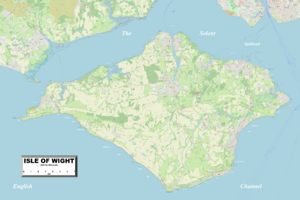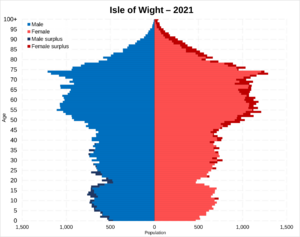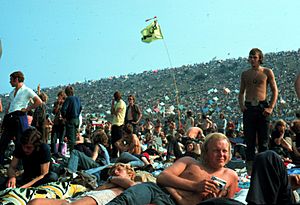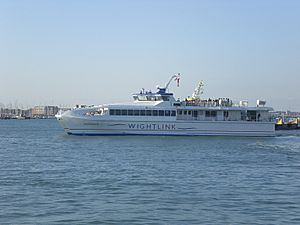Isle of Wight facts for kids
Quick facts for kids
Isle of Wight
|
|||||||||||||||||||||||||||||||||||||||||||||||||
|---|---|---|---|---|---|---|---|---|---|---|---|---|---|---|---|---|---|---|---|---|---|---|---|---|---|---|---|---|---|---|---|---|---|---|---|---|---|---|---|---|---|---|---|---|---|---|---|---|---|
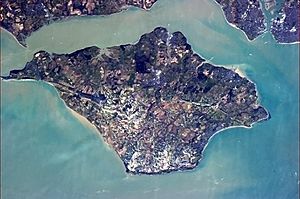
An image of the Isle of Wight from the ISS
|
|||||||||||||||||||||||||||||||||||||||||||||||||
|
|||||||||||||||||||||||||||||||||||||||||||||||||
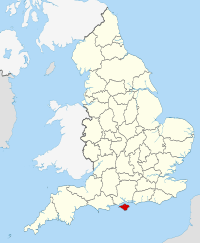 |
|||||||||||||||||||||||||||||||||||||||||||||||||
| Sovereign state | United Kingdom | ||||||||||||||||||||||||||||||||||||||||||||||||
| Constituent country | England | ||||||||||||||||||||||||||||||||||||||||||||||||
| Region | South East | ||||||||||||||||||||||||||||||||||||||||||||||||
| Time zone | UTC±00:00 (Greenwich Mean Time) | ||||||||||||||||||||||||||||||||||||||||||||||||
| • Summer (DST) | UTC+01:00 (British Summer Time) | ||||||||||||||||||||||||||||||||||||||||||||||||
| Member of Parliament |
|
||||||||||||||||||||||||||||||||||||||||||||||||
| Police | Hampshire and Isle of Wight Constabulary | ||||||||||||||||||||||||||||||||||||||||||||||||
|
|||||||||||||||||||||||||||||||||||||||||||||||||
The Isle of Wight (/waɪt/ WYTE) is an island, English county and unitary authority in the English Channel, 2 to 5 miles (3 to 8 kilometres) off the coast of Hampshire, across the Solent. It is the largest and second-most populous island in England. Referred to as "The Island" by residents, the Isle of Wight has resorts that have been popular holiday destinations since Victorian times. It is known for its mild climate, coastal scenery, and verdant landscape of fields, downland, and chines. The island is historically part of Hampshire. The island is designated a UNESCO Biosphere Reserve. With a land area of 380 km2 (150 sq mi), it is about half the size of Singapore.
The island has been home to the poets Algernon Charles Swinburne and Alfred, Lord Tennyson. Queen Victoria built her summer residence and final home, Osborne House, at East Cowes on the Isle. It has a maritime and industrial tradition of boat-building, sail-making, the manufacture of flying boats, hovercraft, and Britain's space rockets. The island hosts annual music festivals, including the Isle of Wight Festival, which in 1970 was the largest rock music event ever held. It has well-conserved wildlife and some of Europe's richest cliffs and quarries of dinosaur fossils.
The island has played an essential part in the defence of the ports of Southampton and Portsmouth and has been near the front line of conflicts through the ages, having faced the Spanish Armada and weathered the Battle of Britain. Being rural for most of its history, its Victorian fashionability and the growing affordability of holidays led to significant urban development during the late 19th and early 20th centuries.
The island was historically a part of Hampshire, but became a separate administrative county in 1890. It had continued to share the Lord Lieutenant of Hampshire until 1974, when it was made a ceremonial county in its own right. The island no longer has administrative links to Hampshire. However, the two counties continue to share their police force and fire and rescue service, and the island's Anglican churches belong to the Diocese of Portsmouth (originally Winchester). A combined local authority with Portsmouth and Southampton was considered as part of a regional devolution package but was subsequently rejected by the UK government in 2018.
The quickest public transport link to the mainland is the hovercraft (Hovertravel) from Ryde to Southsea. Three vehicle ferries and two catamaran services cross the Solent to Southampton, Lymington, and Portsmouth via the island's largest ferry operator, Wightlink, and the island's second-largest ferry company, Red Funnel. Tourism is the largest industry on the island.
Contents
Name
The oldest records that give a name for the Isle of Wight are from the Roman Empire. It was called Vectis or Vecta in Latin and Iktis or Ouiktis in Greek. Latin Vecta, Old English Wiht, and Old Welsh Gueid and Guith were recorded from the Anglo-Saxon period. The Domesday Book called the island Wit. The modern Welsh name is Ynys Wyth (ynys meaning island). These are all variants of the same name, possibly sharing a Celtic origin with Welsh gwaith 'work', a cognate of both Latin vectis ("lever," or literally "the act of lifting") and Old English wiht ("weight"). It may mean 'place of the division,' since the island divides the two arms of the Solent.
In Old English, inhabitants of the Isle were known as Wihtware.
History
Formation and early history
During the Ice Age, sea levels were lower and the Solent was part of a river flowing south east from current day Poole Harbour towards mid-Channel. As sea levels rose, the river valley became flooded, and the chalk ridge line west of the Needles breached to form the island.
The first inhabitants are assumed to have been hunter-gatherers migrating by land during the Paleolithic or Old Stone Age period, as the ice age began to recede. From the Neolithic era onwards, there are indications that the island had wide trading links, with a port at Bouldnor, evidence of Bronze Age tin trading, and finds of Late Iron Age coins.
Caesar reported that the Belgae took the Isle of Wight in about 85 BC and gave its name as Vectis. The Roman historian Suetonius mentions that the island was captured by the commander Vespasian. The Romans built no towns or roads on the island, but the remains of at least seven Roman villas have been found, indicating the prosperity of local agriculture.
During the Dark Ages the island was settled by Jutes as the pagan kingdom of Wihtwara under King Arwald. In 685 it was invaded by Caedwalla, who tried to replace the inhabitants with his own followers. In 686 Arwald was defeated and the island became the last part of English lands to be converted to Christianity, added to Wessex and then becoming part of England under Alfred the Great, included within the shire of Hampshire.
It suffered especially from Viking raids, and was often used as a winter base by Viking raiders when they were unable to reach Normandy. Later, both Earl Tostig and his brother Harold Godwinson (who became King Harold II) held manors on the island.
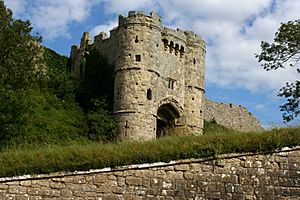
Middle Ages
The Norman Conquest of 1066 created the position of Lord of the Isle of Wight, the island being given by William the Conqueror to his kinsman William FitzOsbern. Carisbrooke Priory and the fort of Carisbrooke Castle were then founded. Allegiance was sworn to FitzOsbern rather than the king; the Lordship was subsequently granted to the de Redvers family by Henry I, after his succession in 1100.
For nearly 200 years the island was a semi-independent feudal fiefdom, with the de Redvers family ruling from Carisbrooke. The final private owner was the Countess Isabella de Fortibus, who, on her deathbed in 1293, was persuaded to sell it to Edward I. Thereafter the island was under control of the English crown and its Lordship a royal appointment.
The island continued to be attacked from the continent, raided in 1374 by the fleet of Castile, and in 1377 by French raiders who burned several towns, including Newtown, and laid siege to Carisbrooke Castle before they were defeated.
Early modern period
Under Henry VIII, who developed the Royal Navy and its Portsmouth base, the island was fortified at Yarmouth, Cowes, East Cowes, and Sandown.
The French invasion on 21 July 1545 (famous for the sinking of the Mary Rose on the 19th) was repulsed by local militia.
During the English Civil War, King Charles fled to the Isle of Wight, believing he would receive sympathy from the governor Robert Hammond. But Hammond imprisoned the king in Carisbrooke Castle.
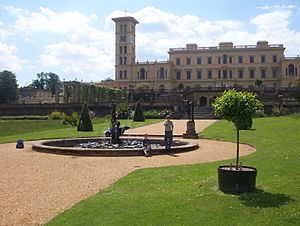
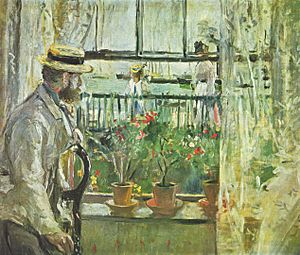
During the Seven Years' War, the island was used as a staging post for British troops departing on expeditions against the French coast, such as the Raid on Rochefort. During 1759, with a planned French invasion imminent, a large force of soldiers was stationed there. The French called off their invasion following the Battle of Quiberon Bay.
Modern history
In the 1860s, what remains in real terms the most expensive ever government spending project saw fortifications built on the island and in the Solent, as well as elsewhere along the south coast, including the Palmerston Forts, The Needles Battery and Fort Victoria, because of fears about possible French invasion.
Queen Victoria spent childhood holidays on the island and became fond of it. When Queen she made Osborne House her winter home, and so the island became a fashionable holiday resort, including for Alfred, Lord Tennyson, Julia Margaret Cameron, and Charles Dickens (who wrote much of David Copperfield there), as well as the French painter Berthe Morisot and members of European royalty. Until then, the island had been rural, with most people employed in farming, fishing or boat-building. The boom in tourism, spurred by growing wealth and leisure time, and by Victoria's example, led to significant urban development of the island's coastal resorts.
Queen Victoria died at Osborne House on 22 January 1901, aged 81.
During her reign, the world's first radio station was set up by Marconi in 1897 at the Needles Battery, at the western tip of the island. In 1898 the first paid telegram (called a 'Marconigram' at the time) was sent from this station, and the island is now the home of the National Wireless Museum, near Ryde.
During the Second World War the island was frequently bombed. With its proximity to German-occupied France, the island hosted observation stations and transmitters, as well as the RAF radar station at Ventnor. It was the starting-point for one of the earlier Operation Pluto pipelines to feed fuel to Europe after the Normandy landings.
The Needles Battery was used to develop and test the Black Arrow and Black Knight space rockets, which were subsequently launched from Woomera, Australia.
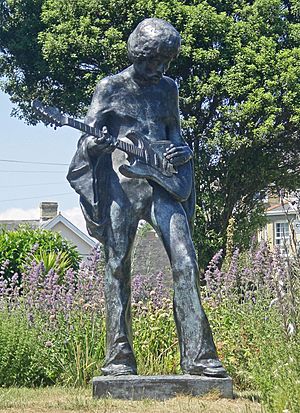
The Isle of Wight Festival was a very large rock festival that took place near Afton Down, West Wight in 1970, following two smaller concerts in 1968 and 1969. The 1970 show was notable both as one of the last public performances by Jimi Hendrix and for the number of attendees, reaching by some estimates 600,000. The festival was revived in 2002 in a different format, and is now an annual event.
Governance
The island had a single Member of Parliament until 2024. The Isle of Wight constituency covered the entire island, with 138,300 permanent residents in 2011, being one of the most populated constituencies in the United Kingdom (more than 50% above the English average). In 2011 following passage of the Parliamentary Voting System and Constituencies Act, the Sixth Periodic Review of Westminster constituencies was to have changed this, but this was deferred to no earlier than October 2022 by the Electoral Registration and Administration Act 2013. Thus the single constituency remained for the 2015, 2017 and 2019 general elections. However, two separate constituencies, Isle of Wight East and Isle of Wight West were created for the island under the 2022 review, and were first contested in the 2024 general election.
The Isle of Wight is a ceremonial and non-metropolitan county. Since the abolition of its two borough councils and restructuring of the Isle of Wight County Council into the new Isle of Wight Council in 1995, it has been administered by a single tier Island Council which has the same powers as a unitary authority in England.
Elections in the constituency have traditionally been a battle between the Conservatives and the Liberal Democrats. Andrew Turner of the Conservative Party gained the seat from Peter Brand of the Lib Dems at the 2001 general election. Since 2009, Turner was embroiled in controversy over his expenses, health, and relationships with colleagues, with local Conservatives having tried but failed to remove him in the runup to the 2015 general election. He stood down prior to the 2017 snap general election, and the new Conservative Party candidate Bob Seely was elected with a majority of 21,069 votes.
At the Isle of Wight Council election of 2013, the Conservatives lost the majority which they had held since 2005 to the Island Independents, with Island Independent councillors holding 16 of the 40 seats, and a further five councillors sitting as independents outside the group. The Conservatives regained control, winning 10 more seats and taking their total to 25 at the 2017 local election, before losing 7 seats in 2021. A coalition entitled the Alliance Coalition was formed between independent, Green Party and Our Island councillors, with independent councillor Lora Peacey-Wilcox leading the council since May 2021.
There have been small regionalist movements: the Vectis National Party and the Isle of Wight Party; but they have attracted little support at elections.
Geography and environment
The Isle of Wight is situated between the Solent and the English Channel, is roughly rhomboid in shape, and covers an area of 150 sq mi (380 km2). Slightly more than half, mainly in the west, is designated as the Isle of Wight Area of Outstanding Natural Beauty. The island has 100 sq mi (258 km2) of farmland, 20 sq mi (52 km2) of developed areas, and 57 miles (92 km) of coastline. Its landscapes are diverse, leading to its oft-quoted description as "England in miniature". In June 2019 the whole island was designated a UNESCO Biosphere Reserve, recognising the sustainable relationships between its residents and the local environment.
West Wight is predominantly rural, with dramatic coastlines dominated by the chalk downland ridge, running across the whole island and ending in the Needles stacks. The southwestern quarter is commonly referred to as the Back of the Wight, and has a unique character. The highest point on the island is St Boniface Down in the south east, which at 241 m (791 ft) is a marilyn. The most notable habitats on the rest of the island are probably the soft cliffs and sea ledges, which are scenic features, important for wildlife, and internationally protected.
The island has three principal rivers. The River Medina flows north into the Solent, the Eastern Yar flows roughly northeast to Bembridge Harbour, and the Western Yar flows the short distance from Freshwater Bay to a relatively large estuary at Yarmouth. Without human intervention the sea might well have split the island into three: at the west end where a bank of pebbles separates Freshwater Bay from the marshy backwaters of the Western Yar east of Freshwater, and at the east end where a thin strip of land separates Sandown Bay from the marshy Eastern Yar basin.
The Undercliff between St Catherine's Point and Bonchurch is the largest area of landslip morphology in western Europe.
The north coast is unusual in having four high tides each day, with a double high tide every twelve and a half hours. This arises because the western Solent is narrower than the eastern; the initial tide of water flowing from the west starts to ebb before the stronger flow around the south of the island returns through the eastern Solent to create a second high water.
Geology
The Isle of Wight is made up of a variety of rock types dating from early Cretaceous (around 127 million years ago) to the middle of the Palaeogene (around 30 million years ago). The geological structure is dominated by a large monocline which causes a marked change in age of strata from the northern younger Tertiary beds to the older Cretaceous beds of the south. This gives rise to a dip of almost 90 degrees in the chalk beds, seen best at the Needles.
The northern half of the island is mainly composed of clays, with the southern half formed of the chalk of the central east–west downs, as well as Upper and Lower Greensands and Wealden strata. These strata continue west from the island across the Solent into Dorset, forming the basin of Poole Harbour (Tertiary) and the Isle of Purbeck (Cretaceous) respectively. The chalky ridges of Wight and Purbeck were a single formation before they were breached by waters from the River Frome during the last ice age, forming the Solent and turning Wight into an island. The Needles, along with Old Harry Rocks on Purbeck, represent the edges of this breach.
All the rocks found on the island are sedimentary, such as limestones, mudstones and sandstones. They are rich in fossils; many can be seen exposed on beaches as the cliffs erode. Lignitic coal is present in small quantities within seams, and can be seen on the cliffs and shore at Whitecliff Bay. Fossilised molluscs have been found there, and also on the northern coast along with fossilised crocodiles, turtles and mammal bones; the youngest date back to around 30 million years ago.
The island is one of the most important areas in Europe for dinosaur fossils. The eroding cliffs often reveal previously hidden remains, particularly along the Back of the Wight. Dinosaur bones and fossilised footprints can be seen in and on the rocks exposed around the island's beaches, especially at Yaverland and Compton Bay, from the strata of the Wessex Formation. As a result, the island has been nicknamed "Dinosaur Island" and Dinosaur Isle was established in 2001.
The area was affected by sea level changes during the repeated Quaternary glaciations. The island probably became separated from the mainland about 125,000 years ago, during the Ipswichian interglacial.
-
Ordnance Survey map of the island
-
Blackgang Chine, circa 1910
-
A view of the Needles and Alum Bay
Climate
Like the rest of the UK, the island has an oceanic climate, but is somewhat milder and sunnier, which makes it a holiday destination. It also has a longer growing season. Lower Ventnor and the neighbouring Undercliff have a particular microclimate, because of their sheltered position south of the downs. The island enjoys 1,800–2,100 hours of sunshine a year. Some years have almost no snow in winter, and only a few days of hard frost. The island is in Hardiness zone 9.
| Climate data for Shanklin | |||||||||||||
|---|---|---|---|---|---|---|---|---|---|---|---|---|---|
| Month | Jan | Feb | Mar | Apr | May | Jun | Jul | Aug | Sep | Oct | Nov | Dec | Year |
| Mean daily maximum °C (°F) | 8.5 (47.3) |
8.3 (46.9) |
9.8 (49.6) |
12.1 (53.8) |
15.0 (59.0) |
17.3 (63.1) |
19.4 (66.9) |
19.9 (67.8) |
15.4 (59.7) |
15.0 (59.0) |
12.1 (53.8) |
9.5 (49.1) |
13.5 (56.3) |
| Mean daily minimum °C (°F) | 4.8 (40.6) |
4.3 (39.7) |
5.4 (41.7) |
7.0 (44.6) |
9.8 (49.6) |
12.4 (54.3) |
14.6 (58.3) |
15.1 (59.2) |
13.5 (56.3) |
11.1 (52.0) |
8.0 (46.4) |
5.6 (42.1) |
9.3 (48.7) |
| Average precipitation mm (inches) | 76.4 (3.01) |
56.3 (2.22) |
47.1 (1.85) |
46.8 (1.84) |
44.9 (1.77) |
42.5 (1.67) |
40.1 (1.58) |
50.9 (2.00) |
57.0 (2.24) |
87.5 (3.44) |
87.8 (3.46) |
88.1 (3.47) |
725.4 (28.55) |
| Average precipitation days (≥ 1.0) | 12.1 | 10.2 | 9.0 | 8.5 | 7.5 | 7.0 | 6.6 | 7.8 | 7.9 | 11.8 | 13.5 | 13.2 | 115.1 |
| Mean monthly sunshine hours | 68.2 | 89.8 | 132.9 | 201.4 | 241.1 | 247.7 | 262.3 | 240.9 | 173.1 | 122.3 | 82.6 | 60.7 | 1,923 |
| Source: Met Office Climate Averages, St Catherines Point, 1991–2020 (Sunshine hours from 1981–2010 stats) | |||||||||||||
Flora and Fauna
The Isle of Wight is one of the few places in England where the European red squirrel is still flourishing, as no competitive grey squirrels are to be found there. Other mammalian species on the island include the European badger, hedgehog, least weasel, red fox and stoat, with the hedgehogs proving to be quite popular amongst locals and visitors alike; in 2019, a rescue and rehabilitation group was organised to assist them, called Save Our Hedgehogs Isle of Wight. The Isle is also home to several protected species, such as the European dormouse and several rare bats, including the western barbastelle.
There are several species of deer on the island, both endemic and non-native, all of which are monitored and surveyed annually by the organisation Isle of Wight Deer Conservation. According to the British Deer Society (BDS), the Isle of Wight Biodiversity Group would like to see the island's ecosystems and flora preserved, one method being to keep the island "deer-free"; however, of the five types of deer documented, the European red deer and roe deer are truly native species, having been known to swim to the island from the mainland.
The diminutive Chinese Reeve's muntjac or barking deer—so-called due to its signature dog-like "bark" when threatened—is one of the smallest deer species on earth and is present on the island. The Asian sika (the second-largest species on the island) and Eurasian fallow deer also will journey to the island from the mainland, generally seen in very small herds, in pairs, or alone. Ultimately, all five of the deer species seen on the Isle of Wight are adept swimmers, thus any that are observed may or may not be long-term Island residents. Nonetheless, the island deer (that are present at any given time) tend to remain strategically hidden and are generally thought of as being difficult to spot, even on such a small island. Besides deer, there exists a colony of feral goats on Ventnor's downs.
The Glanville fritillary, a species of butterfly, has a distribution in the United Kingdom largely restricted to the edges of the island's crumbling cliffs.
A competition in 2002 named the pyramidal orchid as the Isle of Wight's county flower.
The occurrence of species and habitats of conservation importance in the island's waters has led to the designation of a suite of marine protected areas seeking to protect these features, including marine conservation zones (MCZ's) and special areas of conservation (SAC's). The island's marine environment also forms a component of its UNESCO Biosphere Reserve, and is part of the Western English Channel Important Marine Mammal Area (IMMA).
Settlements
- Newport is the centrally located county town, with a population of about 25,000 and the island's main shopping area. Located next to the River Medina, Newport Quay was a busy port until the mid-19th century.
- Ryde, the largest town with a population of about 30,000, is in the northeast. It is Victorian with the oldest seaside pier in England and miles of sandy and pebble beaches.
- Cowes hosts the annual Cowes Week and is an international sailing centre.
- East Cowes is famous for Osborne House, Norris Castle and as the home from 1929 to 1964 of Saunders-Roe, the historic aircraft, flying boat, rocket and hovercraft company.
- Sandown is a popular seaside resort. It is home to the Wildheart Animal Sanctuary, formerly the Isle of Wight Zoo, the Dinosaur Isle geological museum and one of the island's two 18-hole golf courses.
- Shanklin, just south of Sandown, attracts tourists with its high summer sunshine levels, sandy beaches, Shanklin Chine and the old village.
- Ventnor, built on the steep slopes of St Boniface Down on the south coast of the island, leads down to a bay that attracts many tourists. Ventnor Haven is a small harbour.

Economy
Socio-economic data
The table below shows the regional gross value (in millions of pounds) added by the Isle of Wight economy, at current prices, compiled by the Office for National Statistics.
| Year | Regional gross value added |
Agriculture | Industry | Services |
|---|---|---|---|---|
| 1995 | 831 | 28 | 218 | 585 |
| 2000 | 1,369 | 27 | 375 | 800 |
| 2003 | 1,521 | 42 | 288 | 1,161 |
| 2008 | 2,023 | |||
| 2012 | 2,175 |
According to the 2011 census, the island's population of 138,625 lives in 61,085 households, giving an average household size of 2.27 people.
41% of households own their home outright and a further 29% own with a mortgage, so in total 70% of households are owned (compared to 68% for South East England).
Compared to South East England, the island has fewer children (19% aged 0–17 compared to 22% for the South East) and more elderly (24% aged 65+ compared to 16% for the South East), giving an average age of 44 years for an island resident compared to 40 in South East England.
Industry and agriculture
The largest industry on the island is tourism, but it also has a significant agriculture including sheep, dairy farming and arable crops. Traditional agricultural commodities are more difficult to market off the island because of transport costs, but local farmers have succeeded in exploiting some specialist markets, with the higher price of such products absorbing the transport costs. One of the most successful agricultural sectors is now the growing of crops under cover, particularly salad crops including tomatoes and cucumbers. The island has a warmer climate and a longer growing season than much of the United Kingdom. Garlic has been grown in Newchurch for many years, and is, in part, exported to France. This has led to the establishment of an annual Garlic Festival at Newchurch, which is one of the largest events of the local calendar.
A favourable climate supports two vineyards, including one of the oldest in the British Isles at Adgestone. Lavender is grown for its oil. The largest agricultural sector has been dairying, but due to low milk prices and strict legislation for UK milk producers, the dairy industry has been in decline: there were nearly 150 producers in the mid-1980s, but now just 24.
Maritime industries, especially the making of sailcloth and boat building, have long been associated with the island, although this has diminished in recent years. GKN operates what began as the British Hovercraft Corporation, a subsidiary of (and known latterly as) Westland Aircraft, although they have reduced the extent of plant and workforce and sold the main site. Previously it had been the independent company Saunders-Roe, one of the island's most notable historic firms that produced many flying boats and the world's first hovercraft.
Another manufacturing activity is in composite materials, used by boat-builders and the wind turbine manufacturer Vestas, which has a wind turbine blade factory and testing facilities in West Medina Mills and East Cowes.
Bembridge Airfield is the home of Britten-Norman, manufacturers of the Islander and Trislander aircraft. This is shortly to become the site of the European assembly line for Cirrus light aircraft. The Norman Aeroplane Company is a smaller aircraft manufacturing company operating in Sandown. There have been three other firms that built planes on the island.
In 2005, Northern Petroleum began exploratory drilling for oil at its Sandhills-2 borehole at Porchfield, but ceased operations in October that year after failing to find significant reserves.
Breweries
There are three breweries on the island. Goddards Brewery in Ryde opened in 1993. David Yates, who was head brewer of the Island Brewery, started brewing as Yates Brewery at the Inn at St Lawrence in 2000. Ventnor Brewery, which closed in 2009, was the last incarnation of Burt's Brewery, brewing since the 1840s in Ventnor. Until the 1960s most pubs were owned by Mews Brewery, situated in Newport near the old railway station, but it closed and the pubs were taken over by Strong's, and then by Whitbread. By some accounts Mews beer was apt to be rather cloudy and dark. In the 19th century they pioneered the use of screw top cans for export to British India.
Services
Tourism and heritage
The island's heritage is a major asset that has for many years supported its tourist economy. Holidays focused on natural heritage, including wildlife and geology, are becoming an alternative to the traditional British seaside holiday, which went into decline in the second half of the 20th century due to the increased affordability of foreign holidays. The island is still an important destination for coach tours from other parts of the United Kingdom.
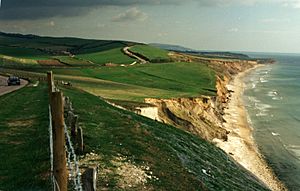
Tourism is still the largest industry, and most island towns and villages offer hotels, hostels and camping sites. In 1999, it hosted 2.7 million visitors, with 1.5 million staying overnight, and 1.2 million day visits; only 150,000 of these were from abroad. Between 1993 and 2000, visits increased at an average rate of 3% per year.
At the turn of the 19th century the island had ten pleasure piers, including two at Ryde and a "chain pier" at Seaview. The Victoria Pier in Cowes succeeded the earlier Royal Pier but was itself removed in 1960. The piers at Ryde, Seaview, Sandown, Shanklin and Ventnor originally served a coastal steamer service that operated from Southsea on the mainland. The piers at Seaview, Shanklin, Ventnor and Alum Bay were all destroyed by various storms during the 20th century; only the railway pier at Ryde and the piers at Sandown, Totland Bay (currently closed to the public) and Yarmouth survive.
Blackgang Chine is the oldest theme park in Britain, opened in 1843. The skeleton of a dead whale that its founder Alexander Dabell found in 1844 is still on display.
As well as its more traditional attractions, the island is often host to walking or cycling holidays through the attractive scenery. An annual walking festival has attracted considerable interest. The 70 miles (113 km) Isle of Wight Coastal Path follows the coastline as far as possible, deviating onto roads where the route along the coast is impassable.
The tourist board for the island is Visit Isle of Wight, a non-profit company. It is the Destination Management Organisation for the Isle of Wight, a public and private sector partnership led by the private sector, and consists of over 1,200 companies, including the ferry operators, the local bus company, rail operator and tourism providers working together to collectively promote the island. Its income is derived from the Wight BID, a business improvement district levy fund.
A major contributor to the local economy is sailing and marine-related tourism.
Summer Camp at Camp Beaumont is an attraction at the old Bembridge School site.
Media
The main local newspaper used to be the Isle of Wight County Press, but its circulation has declined over the years, especially since it was taken over by Newsquest in July 2017. In 2018 a new free newspaper was launched, the Isle of Wight Observer. By 2023 the newcomer was distributing 18,500 copies compared to the Isle of Wight County Press's total circulation of 11,575].
On-line news websites include Island Echo, launched in May 2012, and On the Wight.
The island has a local commercial radio station and a community radio station: commercial station Isle of Wight Radio has broadcast in the medium-wave band since 1990 and on 107.0 MHz (with three smaller transmitters on 102.0 MHz) FM since 1998, as well as streaming on the Internet. Community station Vectis Radio has broadcast online since 2010, and in 2017 started broadcasting on FM 104.6. The station operates from the Riverside Centre in Newport. The island is also covered by a number of local stations on the mainland, including the BBC station BBC Radio Solent broadcast from Southampton. The island's not-for-profit community radio station Angel Radio opened in 2007. Angel Radio began broadcasting on 91.5 MHz from studios in Cowes and a transmitter near Newport.
Important broadcasting infrastructure includes Chillerton Down transmitting station with a mast that is the tallest structure on the island, and Rowridge transmitting station, which broadcasts the main television signal both locally and for most of Hampshire and parts of Dorset and West Sussex.
Culture
Language and dialect
The local accent is similar to the traditional dialect of Hampshire, featuring the dropping of some consonants and an emphasis on longer vowels. It is similar to the West Country dialects heard in South West England, but less pronounced.
The island has its own local and regional words. Some, such as nipper/nips (a young male person), are still commonly used and are shared with neighbouring areas of the mainland. A few are unique to the island, for example overner and caulkhead (see below). Others are more obscure and now used mainly for comic emphasis, such as mallishag (meaning "caterpillar"), gurt meaning "large", nammit (a mid-morning snack) and gallybagger ("scarecrow", and now the name of a local cheese).
Identity
There remains occasional confusion between the Isle of Wight as a county and its former position within Hampshire. The island was regarded and administered as a part of Hampshire until 1890, when its distinct identity was recognised with the formation of Isle of Wight County Council (see also Politics of the Isle of Wight). However, it remained a part of Hampshire until the local government reforms of 1974, when it became a full ceremonial county with its own Lord Lieutenant.
In January 2009, the first general flag for the county was accepted by the Flag Institute.
Island residents are sometimes referred to as "Vectensians", "Vectians" or, if born on the island, "caulkheads". One theory is that this last comes from the once prevalent local industry of caulking or sealing wooden boats; the term became attached to islanders either because they were so employed, or as a derisory term for perceived unintelligent labourers from elsewhere. The term "overner" is used for island residents originating from the mainland (an abbreviated form of "overlander", which is an archaic term for "outsider" still found in parts of Australia).
Residents refer to the island as "The Island", as did Jane Austen in Mansfield Park, and sometimes to the UK mainland as "North Island".
To promote the island's identity and culture, the High Sheriff, Robin Courage, founded an Isle of Wight Day; the first was held on 24 September 2016.
Sport
Sport plays a key part of culture on the Isle of Wight. Sports include golf, marathon, cycling and sailing.
Music
The island is home to the Isle of Wight Festival and until 2016, Bestival, before it was relocated to Lulworth Estate in Dorset. In 1970, the festival was headlined by Jimi Hendrix attracting an audience of 600,000, some six times the local population at the time. It is the home of the bands The Bees, Trixie's Big Red Motorbike, Level 42, and Wet Leg.
Landmarks
| Key | |
| Owned by the National Trust | |
| Owned by English Heritage | |
| Owned by the Forestry Commission | |
| A Country Park | |
| An Accessible open space | |
| Museum (free) | |
| Museum (charges entry fee) | |
| Heritage railway | |
| Historic House | |
- Alum Bay
- Appuldurcombe House

- Amazon World Zoo

- Bembridge Lifeboat Station
- Blackgang Chine

- Brading Roman Villa

- Carisbrooke Castle


- Classic Boat Museum, East Cowes

- Compton Bay
- Dimbola Lodge

- Dinosaur Isle

- Fort Victoria

- Godshill village and model village
- Isle of Wight Bus & Coach Museum

- Isle of Wight Steam Railway

- Isle of Wight Zoo, Yaverland

- Medina Theatre
- The Needles

- Newport Roman Villa
- Osborne House

- Quarr Abbey

- Robin Hill

- Botanic Gardens, Ventnor
- Yarmouth Castle


Transport
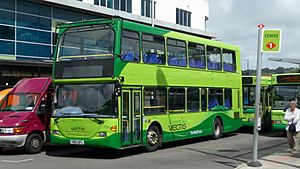
The Isle of Wight has 489 miles (787 km) of roadway. It does not have a motorway, although there is a short stretch of dual carriageway towards the north of Newport near the hospital and prison.
A comprehensive bus network operated by Southern Vectis links most settlements, with Newport as its central hub.
Journeys away from the island involve a ferry journey. Car ferry and passenger catamaran services are run by Wightlink and Red Funnel, and a hovercraft passenger service (the only such remaining in the world) by Hovertravel.
The island formerly had its own railway network of over 55 miles (89 km), but only one line remains in regular use. The Island Line is part of the United Kingdom's National Rail network, running a little under 9 miles (14 km) from Shanklin to Ryde Pier Head, where there is a connecting ferry service to Portsmouth Harbour station on the mainland network. The line was opened by the Isle of Wight Railway in 1864, and from 1996 to 2007 was run by the smallest train operating company on the network, Island Line Trains. It is notable for utilising old ex-London Underground rolling stock, due to the small size of its tunnels and unmodernised signalling. Branching off the Island Line at Smallbrook Junction is the heritage Isle of Wight Steam Railway, which runs for 5+1⁄2 miles (8.9 km) to the outskirts of Wootton on the former line to Newport.
There are two airfields for general aviation, Isle of Wight Airport at Sandown and Bembridge Airport.
The island has over 200 miles (322 km) of cycleways, many of which can be enjoyed off-road. The principal trails are:
- The Sunshine Trail, which is a circular route linking Sandown, Shanklin, Godshill, and Wroxall of 12 miles (19 km);
- The Red Squirrel Trail, a track between Cowes and Sandown that is 32 miles (51 km) in total;
- The Round the Island Cycle Route of 62 miles (100 km).
Prisons
The Isle of Wight is near the densely populated south of England, yet separated from the mainland. This position led to it hosting three prisons: Albany, Camp Hill and Parkhurst, all located outside Newport near the main road to Cowes. Albany and Parkhurst were among the few Category A prisons in the UK until they were downgraded in the 1990s. The downgrading of Parkhurst was precipitated by a major escape: three prisoners (two murderers and a blackmailer) escaped from the prison on 3 January 1995 for four days, before being recaptured. .....
Camp Hill is located adjacent but to the west of Albany and Parkhurst, on the very edge of Parkhurst Forest, having been converted first to a borstal and later to a Category C prison. It was built on the site of an army camp (both Albany and Parkhurst were barracks); there is a small estate of tree-lined roads with the former officers' quarters (now privately owned) to the south and east. Camp Hill closed as a prison in March 2013.
The management of all three prisons was merged into a single administration, under HMP Isle of Wight in April 2009.
Education
There are 69 local education authority-maintained schools on the Isle of Wight, and two independent schools. As a rural community, many of these are small and with fewer pupils than in urban areas. The Isle of Wight College is located on the outskirts of Newport.
From September 2010, there was a transition period from the three-tier system of primary, middle and high schools to the two-tier system that is usual in England. Some schools have now closed, such as Chale C.E. Primary. Others have become "federated", such as Brading C.E. Primary and St Helen's Primary. Christ the King College started as two "middle schools", Trinity Middle School and Archbishop King Catholic Middle School, but has now been converted into a dual-faith secondary school and sixth form.
Since September 2011 five new secondary schools, with an age range of 11 to 18 years, replaced the island's high schools (as a part of the previous three-tier system).
Notable people
Notable residents have included:
17th century and earlier
- King Arwald, last pagan king in England
- King Charles I of England, who was imprisoned at Carisbrooke Castle
- Earl Tostig Godwinson, who supported Norwegian king Harald Hardrada's invasion
- Actor, highwayman and conspirator Cardell "Scum" Goodman
- Soldier and regicide of Charles I Thomas Harrison, imprisoned at Carisbrooke with John Rogers and Christopher Feake
- Soldier Peter de Heyno
- Philosopher and polymath Robert Hooke
- Murderer Michal Morey
18th century
- Marine painter Thomas Buttersworth
- Explorer Anthony Henday
- Radical journalist John Wilkes
19th century
- Queen Victoria and Prince Albert (monarch and consort), who built and lived at Osborne House
- Photographer Julia Margaret Cameron, who lived at Dimbola Lodge
- Irish Republican Thomas Clarke
- Naval captain Jeremiah Coghlan CBG, who retired to Ryde
- Writer Charles Dickens
- Poet John Keats
- Inventor and radio pioneer Guglielmo Marconi
- Poet and hymnwriter Albert Midlane
- Geologist and engineer John Milne
- Regency architect John Nash
- Novelist Miss Harriet Parr
- Early Hong Kong Government administrator William Pedder
- New Zealand PM Henry Sewell
- Poet Algernon Charles Swinburne
- Poet Alfred Tennyson
- Philosopher Karl Marx, who stayed at 1, St. Boniface Gardens, Ventnor
20th century onwards
- Scriptwriter Raymond Allen
- Concert organist E. Power Biggs
- Darts player Keegan Brown
- Singer Helen Clare
- Singer-songwriter Sarah Close
- Inventor of the hovercraft Sir Christopher Cockerell
- Presenter and actor Ray Cokes
- Actress Bella Emberg
- Yachtsman Uffa Fox
- Actor Marius Goring
- Musician Jack Green
- Survival expert and Chief Scout Bear Grylls
- Actress Sheila Hancock
- Actor Melvyn Hayes
- Singer-songwriter Lauran Hibberd
- Folk-rock musician Robyn Hitchcock
- Actor Geoffrey Hughes
- Conspiracy theorist David Icke
- Actor Jeremy Irons
- Comedian Phill Jupitus
- Actor Laura Michelle Kelly
- Composer Albert Ketèlbey
- Iranian poet Mimi Khalvati
- Musician Mark King
- Band Level 42
- Yachtswoman Ellen MacArthur
- BBC Tonight presenter Cliff Michelmore
- Film director Anthony Minghella
- Actor David Niven
- YouTuber Adam Pacitti
- Cyclist Kieran Page
- Professor of biochemistry Samuel Victor Perry
- Musician Frederick Riddle
- Performance artist Nigel Rolfe
- Heptathlete Kelly Sotherton
- Gardener and presenter Alan Titchmarsh
- Novelist Edward Upward
- Band Wet Leg
- Band Grade 2
Overseas names
The Isle of Wight has given names to many parts of former colonies, most notably Isle of Wight County in Virginia founded by settlers from the island in the 17th century. Its county seat is a town named Isle of Wight.
Other notable examples include:
- Isle of Wight – an island off Maryland, United States
- Dunnose Head, West Falkland
- Ventnor, Cowes on Phillip Island, Victoria, Australia
- Carisbrook, Victoria, Australia
- Carisbrook, a former stadium in Dunedin, New Zealand
- Ryde, New South Wales, Australia
- Shanklin, Sandown, New Hampshire, United States
- Ventnor City, New Jersey, United States
- Gardiners Island, New York, United States shown as "Isle of Wight" on some of the older maps.
See also
 In Spanish: Isla de Wight para niños
In Spanish: Isla de Wight para niños





